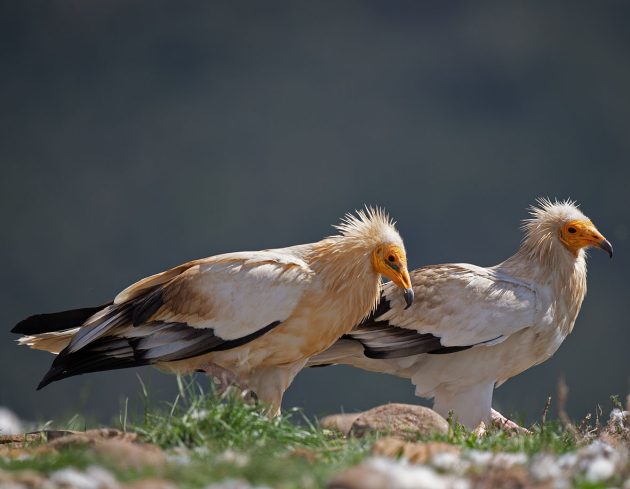The Egyptian Vulture Neophron percnopterus has been one of my favourite birds since I was little. Look at it close up and it does look grotesque. I couldn’t describe it better than Willoughby Verner did in his book “My Life Among the Wild Birds in Spain” published in 1909: “It is when the Egyptian Vulture or Neophron, as it is also styled, is seen close at hand that it is revealed in all its hideousness. The bright yellow shrivelled-up skin of the naked head is most repulsive…and yet it must be repeated few birds present a finer sight when on the wing…”. I don’t share Verner’s total disgust with the landed bird but I do agree that seeing this bird on the wing is something quite special.
The bird, a summer visitor to Europe from winter quarters in the Sahel, is in decline across the continent. Its stronghold is the Iberian Peninsula. The most recent estimates suggest that some 1,500 pairs breed in Spain. That’s about half of the entire European breeding population. The population of Egyptian Vultures in Italy is nearing extinction, with fewer than 10 pairs, and numbers are also going down in the Balkans, now with fewer than 70 pairs.

The latest Spanish breeding bird atlas (2014-18) compares the results with the previous atlas (1998-2002) and shows that Egyptian Vultures continued to breed in 60% of squares examined. They had disappeared from 16% but new sites accounted for 24%. So, at this stage, losses were being covered by gains at new sites. This corresponds well with observations of migrating Egyptian Vultures at the Strait of Gibraltar bottleneck where seasonal counts today are of the order of 3,000 birds, not dissimilar to those done in the 1970s.

Looking at Spain’s southernmost region, Andalucia, we see that the population has remained steady, at around 25 pairs, since 2004. Look further back, to the first census undertaken and the number of breeding pairs had been estimated at 94 in 1987. So our picture changes to one of sharp decline in recent decades. The population is small and fragmented and considered to be in danger of extinction. Causes? The main ones are death by poisoning and by collision with windmills. Egyptian Vultures are particularly sensitive and vulnerable to windmills. Loss of habitat, disturbance and death by electrocution on high voltage cables are additional factors. Windmills are the cause of habitat destruction and death of so many birds and I find it annoying that these windmills are being put up “in the name of green”. It seems that these environmental, climate change-driven, agendas have been taken over by those with little knowledge of or empathy for the rest of life that lives in and shares this planet with us. Is the loss of populations and species of birds the price to be paid for a miniscule reduction in the carbon footprint? Where is the sustainability in that? History will judge us.

My passage above hints at something else that concerns me. This is the idea of shifting baselines. Take a look at the Egyptian Vulture population since 2004 and, with no prior knowledge, you would say it’s stable. Go back to 1987 and you begin to see a serious decline. But by 1987 the Egyptian Vulture population in Andalucia was already reduced. Now, let’s take it back even further. The ornithologist Howard Irby writing in his book “The Ornithology of the Straits of Gibraltar” written in 1895, had this to say of the Egyptian Vulture in southern Iberia then: “Near Gibraltar, Neophrons, during their stay, are abundantly distributed…Many pass northwards at the end of February…and the greater number, many hundreds, almost always in pairs, pass during March.” So if we shift our baseline back to Irby’s day we would have to conclude that the Egyptian Vulture, in southern Iberia at least, is a case of the “living dead”, a population that is a shadow of its former self and whose days are numbered, and only just kept alive largely by chance and no thanks to those “environmentally friendly” windmills.

Source link

